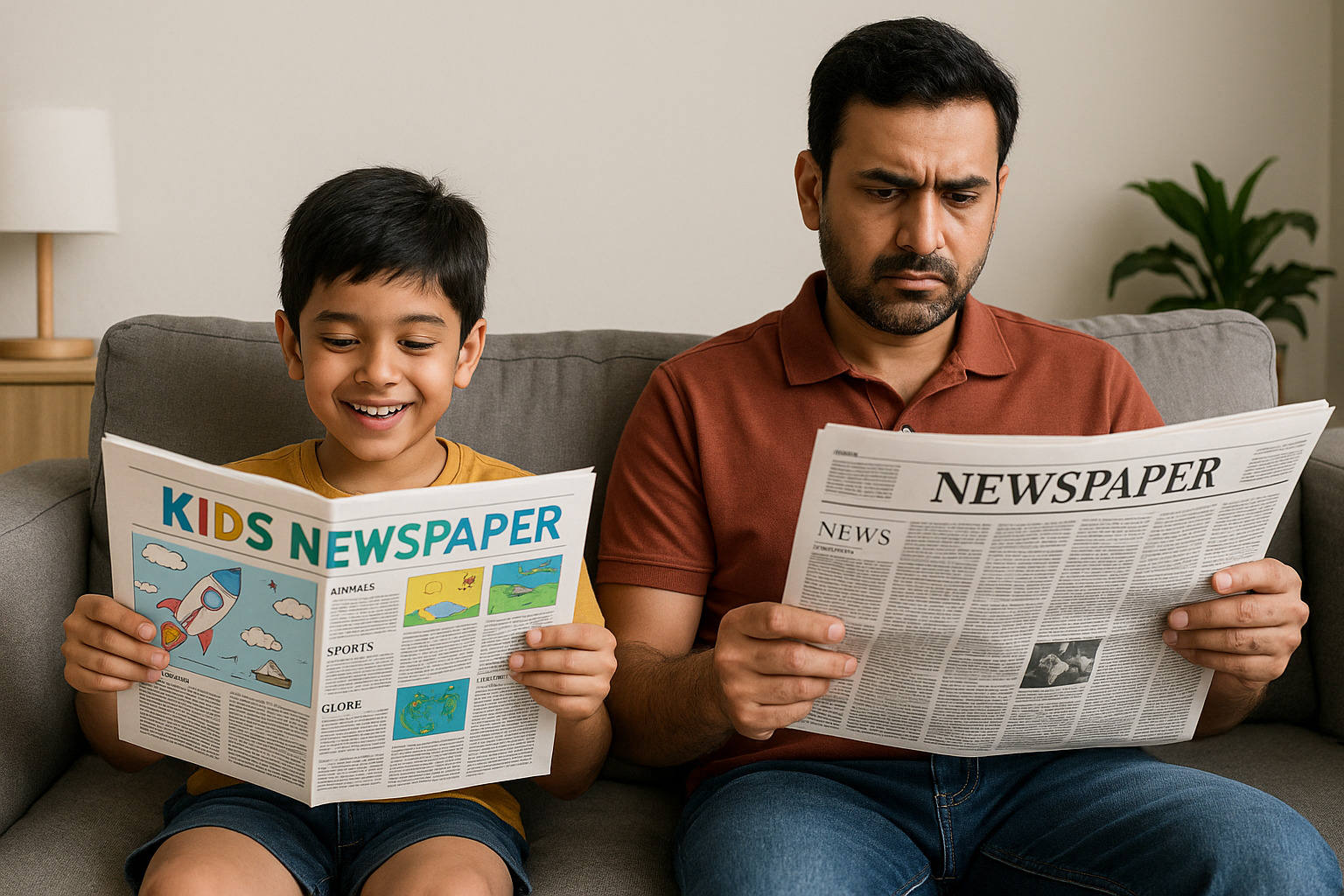
Difference Between Kids Newspapers and General Newspapers
As a child education specialist and school counselor, I often encounter parents who say, “We already have a daily newspaper at home – why do I need a separate newspaper for my kids?” It’s a valid question – but they don’t know what kids’ newspapers actually are and how different they are from regular newspapers.They understand that both aim to inform and educate, but their tone, content, presentation and purpose are completely different. And to a young, developing mind, these differences matter more than most parents realize.
In this blog, I’ll tell you the key differences between kids’ newspapers and regular newspapers, and how choosing the right newspaper can impact your child’s reading habits, worldview and learning journey.
1. Content Complexity
General Newspapers:
They are written with an adult readership in mind and often use complex vocabulary, formal tone, political and advanced sentence structures. News topics range from economics, geopolitics and stock markets to crime, controversy and policy debates. While they are undoubtedly informative, they are not necessarily information appropriate for children.Kids Newspapers:
Kids Newspapers are specifically created to match a child's age, reading level and cognitive understanding. Topics are simple, clearly explained, and often focus on education, the environment, inventions, inspiring stories, quizzes, space science and other curiosity-driven content. The aim is to arouse interest without confusion or fear."Kid-friendly content ensures understanding without needing constant adult explanation."
2. Visual Engagement
General Newspapers:
They are primarily text-heavy and minimalist. Images are often small, and also grim, and may contain disturbing or graphic visuals inappropriate for children.Kids Newspapers:
Kids' newspapers are Highly visual and interactive because of using colorful layouts, infographics, comic strips, illustrations, puzzles, and even DIY activities to inspire excitement and curiosity in kids. They're not just for fun - they're designed to improve visual literacy, retention, and engagement."Children process visuals faster than text. Kid newspapers use this advantage to make learning enjoyable."
3. Emotional Appropriateness
General Newspapers:
Let’s be honest, while important for adults, our daily newspapers are filled with harsh realities: political conflicts, economic crises, accidents, violence, and negative news cycles. This constant exposure can be upsetting and emotionally draining for young minds.Kids Newspapers:
These newspapers use carefully curated news that is appropriate for young minds. If sensitive topics are covered, in kids newspaper they were explained with context, care, and constructive findings. The focus is on positive storytelling, learning, and developing empathy without fear."Kids need hope and inspiration, not anxiety and cynicism."
4. Language Style and Learning Focus
General newspapers:
General newspapers use dense and journalistic language. These are designed for readers who are already fluent, critical thinkers and able to understand nuance.
Kids' newspapers:
Kids' newspapers on the other hand use simple, engaging and age-appropriate language. Every story is written with an underlying learning purpose - whether it's vocabulary enrichment, moral reasoning or critical thinking. Many include vocabulary boxes, fun facts and activity prompts to support learning. Learn our full blog here where we discuss that why every kid should read a kids newspaper.
"The right reading level builds fluency, confidence, and a love for reading."
5. Purpose and Educational Value
General Newspapers:
Serve the purpose of informing, analyzing, and influencing public opinion. Their scope is broad and often targeted at adults with specific interests like finance, politics, or global affairs.Kids Newspapers:
Created with a different mission: to develop reading habits, stimulate curiosity, build general knowledge, and support school learning in a fun, non-academic format. They align better with classroom discussions and child development goals."Kids newspapers are an extension of learning, not just news."
6. Interactivity and Child Participation
General Newspapers:
Offer little to no interactive content. Children are passive readers—if they read it at all.Kids Newspapers:
Often include interactive sections like puzzles, crosswords, quiz corners, creative writing challenges, art features, and even opportunities for kids to get published. These features motivate kids to engage actively rather than consume passively."Kids love seeing their work or name in print—it builds pride and motivation."
7. Sense of Identity and Belonging
General Newspapers:
Children don’t relate to adult-centric topics. There’s no sense of ownership or connection.Kids Newspapers:
Curated to reflect a child’s world—school life, friendships, hobbies, curiosity, and creativity. This helps children feel that this newspaper is specially made for them. They connect emotionally with it and are more likely to build a consistent reading habit.So, Should Kids Read General Newspapers at All?
Eventually—yes. But not as their first exposure to current affairs. Introducing children to adult newspapers too early may discourage them from reading altogether due to difficulty or disinterest.
Think of it like this: You wouldn’t ask a child to drive a car before they learn how to ride a bicycle. Similarly, kids newspapers are the training ground that prepares children to become lifelong, informed readers.
As parents, we all want our children to grow up informed, articulate, and aware of the world. But how they reach that stage is just as important as the end goal.
Starting with a high-quality kids newspaper—like The Youth Express—ensures your child gets age-appropriate exposure, builds a positive reading habit, and gradually grows into more advanced media.
So, next time you think your daily newspaper is enough for your child, remember:
They need something written for them, not around them.
Let’s empower our children with the right tools to become readers who don’t just read the news—but understand it, enjoy it, and grow because of it.
"Thank you for reading! If you enjoyed this blog, we invite you to explore our other insightful articles on children's learning, reading habits, and educational tools."






